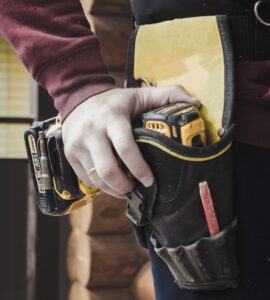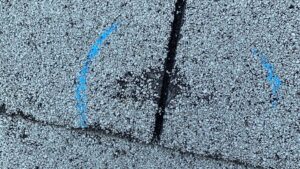Hail is a natural event that damages roofs, accounting for between $8 billion and $14 billion in insurance claims annually.
Hailstorms are hardly unheard of, especially in Minneapolis. When it comes to hailstorms, the United States sees the most of them between May and August. Homeowners who live in an area known as “hail alley” in the United States are at greater risk of hail damage. It includes sections of Colorado, Nebraska, and Wyoming, as well as a portion of the Midwestern states.
Your roof can be pounded by ice that ranges from tiny pea or mothball-sized pellets to grapefruit-sized rocks during this time.
It is never a good thing for your roof when ice starts to fall from the sky. Just about anything that falls from the sky can do serious damage to shingles, gutters and metal flashing as well as shattered siding or broken windows. However, at other times, the damage is virtually undetectable.
Natural and regular weather events, such as hail, should be regarded very seriously. When it comes to the weather, it’s impossible to assume that your roof will be able to resist it all. Minor hailstorms can rip open roofing materials, causing damage or leaks down the road.
When it comes to hail, it’s crucial to know what kind of damage it can inflict and how to fix it.

What Kind of Hail Damages Roofs
Size, density, and impact speed all affect hail damage. Intensity of a storm impacts how quickly and densely hail falls.
Hail is grouped into sizes similar to other objects.
· Pea or ¼ inch diameter: hail this small generally doesn’t cause impact damage
· Mothball or 1/2 inch: hail this small is unlikely to cause impact damage unless the storm was severe
· Penny or 3/4 inch: this hail can cause granule loss, chip windows, tear screens, damage metal components, chip paint, and damage siding
· Quarter or 1 inch: this can damage shingles straight through to the underlayment and tear apart gutters, flashing, and fascia; severe wind conditions worsen the damage
· Ping-Pong Ball or 1 ¼ to 1 1/2 inch: this is always bad news and can cause the same damage as inch sized hail, regardless of wind conditions or storm severity
· Golf Ball or 1 3/4 inches: this hail breaks windows, ridge caps, plastic vents, metal flashing, gutters, and can tear off siding
· Tennis Ball or 2 1/2 inches: anything above 2 inches will cause severe property damage
The size of the hail can tell you a lot about the extent of the damage. The roof should be fine if only a small amount of pea-sized hail fell.
However, hail the size of tennis balls, baseballs, softballs, or grapefruits is almost certain to damage your roof. The best course of action in this situation is to contact a local roofing company that offers 24-hour emergency service.
How Hail Damages Shingles
Asphalt shingles are the most popular type of roof, so we’ll start here. Hail damage includes:
· Surface granule loss
· Shingle bruising
· Dents and pings
· Cracks, breaks, or tears
· Weakened seals
Hail frequently damages the surface granule covering. On impact, the granules might become loose or rub off, resulting in bald patches or decreased density. It may not appear to be much, but any area with reduced density is more prone to water penetration.
The hail’s impact can cause the shingle’s seal to weaken or break free. Hail can occasionally knock shingles out of place. Impact marks such as dents, pings, or black areas can appear on shingles.
Shingle bruising happens when the surface of the shingles is injured and the underlying mat is shattered. Bruising is a type of functional damage produced by larger hailstones. This must be repaired right now.
How Hail Damages Other Popular Roofing Materials
Other roofing materials perform differently in the face of hail. Some dent only on impact, while others break, tear off, or split open.
Here’s how a few common types handle hail:
· Metal: white scuff marks, dents, cracks, or breaks
· Wood: splits and breaks
· Clay or Slate: cracks, dents, chips, gouging
Damage to materials like these may be easier to detect. Examine the item for chips, splits, tears, cracks, and scuff marks.

How Hail Damages Vents, Flashing, Gutters, Siding, and Windows
Other portions of the roof or house are often simpler to identify hail damage on. Roof vents, flashing, gutters, siding, and windows are all included.
Rooftop Vents or Flashing:
· indentations
· pockmarks
· breaks
Gutters:
· dents
· tears
· hanging pieces
Windows:
· screen tears or holes
· chips in the glass
Metal vents and flashing can become severely damaged. You might want to start there if you want to make a rapid judgment of how severe a storm was.
Hail Damage Can Worsen If Left Alone
There is no such thing as a problem that can be ignored when it comes to roofs. Both the shingle and structural damage will deteriorate over time.
Granule loss, for example, may appear insignificant, but it weakens the primary barrier against water. As a result, the layers are less protected against moisture.
If granules are removed when the first layer of a shingle is chipped, the layers beneath are entirely exposed, and roof leaks are not far behind.
Roofs become vulnerable, more prone to damage, and more sensitive to the elements when they sustain damage.
As a result, everything that jeopardizes the roof’s seal, water resistance, weather performance, structure, or integrity must be repaired – no matter how minor.
How to Get Hail Damage Repaired and Have Insurance Pay
Is there any evidence of hail damage? Have this taken care of as soon as possible. Even if you don’t see any post-storm damage, hire an expert to inspect the property.
There are two reasons why you should do this:
1. Hail damage – even when minor – worsens over time
2. Insurance typically doesn’t cover old hail damage
Think you can get away with it because the roof isn’t leaking or the shingles haven’t been ripped off? You’re preparing for a major roofing repair work that won’t be covered by insurance.
Here’s how to proceed.
1. Schedule a roof inspection
2. Make an insurance claim
3. Get the roof repaired
In order to inspect your roof, you need hire a licensed, insured, bonded, and skilled roofing contractor. Roofing inspections should be performed at least twice a year to look for general damage, wear and tear, and degradation.
However, you should obtain one after extreme weather events such as high winds, which might pelt your roof with hail, ice, or flying items. This will detect any damage as soon as it occurs, making it simple to repair and preventing things from growing worse.
After then, it’s time to bring in the insurance company. You can tell them what the roofing inspector mentioned while you were on the phone.
The insurance company will dispatch an adjuster to conduct their own evaluation, then consult with your roofing inspector before deciding whether or not to approve the claim.
After then, it’s time to start thinking about repairs or a whole roof replacement.
Inspecting a Roof for Hail Damage
A hail assessment looks for damage to the roof and other exterior elements. The inspector will assess the severity of any damage, measure the approximate size of any holes, and produce a report.
Places checked should include:
· Roof shingles or tiles
· Rooftop vents and metal flashing
· Gutters
· Siding
· Windows and skylights
· Decking
Damage signs should include:
· Granule loss
· Shingles with dots, spots, or dings
· Shingle cracks, lifts, and bruising
· Breaks or tears in roof tiles
· Exposed and damaged fiberglass mats
· Exposed underlayment
· Loose or weak sealing strips
· Dents, scuffs, or tears in vents
If the storm was strong or there are evidence of damage, the inspector may also want to go inside the house.
What Kind of Hail Damage Insurance Will Pay For
Insurance companies cover fresh hail damage that impairs the performance of the roof. They don’t enjoy paying for previous damage or anything just cosmetic.
We’ve all seen how cheap insurance companies can be. They want to avoid paying for as much as possible.
As a result, while hail damage is recognized as a covered “act of God,” most insurance companies disting
· Cosmetic damage is surface-level and makes things look bad, but doesn’t affect the roof
· Functional damage compromises the roof’s performance or structural integrity
The distinction is usually determined by size and severity. Insurance companies are not compelled by law to pay for aesthetic damage. They are, however, intended to cover functional harm.
Be mindful that perspectives on what qualifies as functional versus purely cosmetic differ frequently. Insurance companies are constantly attempting to avoid paying for functional damage. This includes huge holes that must be repaired right away.
This is why it’s vital to work with a skilled roofing contractor who begins with an impartial assessment. They will tell you exactly what has to be repaired and what constitutes functional damage.
Experienced roofers also understand how to present this material to insurance companies in a way that confirms your claim. When working with someone who knows what they’re doing, insurance firms are a little more likely to comply. If your insurance company still refuses to cooperate, a public insurance adjuster can step in.
How Hail Damage Is Repaired
The restoration process differs based on the type and severity of the damage, which is often determined by the size of the hail. But, once again, there is no such thing as roof damage that does not require repair.
This doesn’t have to be an expensive ordeal. The restoration work should be proportionate to the harm. Roofers can repair individual shingles when only a few are broken, or they can conduct partial reroofing work in specific locations.
Work like this is rapid and reasonably priced. Especially as compared to rebuilding larger roofing portions if the damage is allowed to grow.
Storms must be rather severe for hail damage to necessitate a total roof replacement. However, this does occur, particularly in Colorado, Nebraska, and Wyoming’s Hail Alley. If this is the case, a full roof replacement normally takes between one and five days. Shingles can be replaced more quickly, whilst other tiling techniques can take up to a week.
However, if your roof has been neglected over the years, it may require more maintenance than thought. If difficulties like this arise during an inspection, the best thing to do is call your insurance company and file a claim.
By the way, insurance companies are known to deny coverage to roofs with long-standing hail damage. This is one area where attempting to save money in the near term might lead to expensive charges in the long run.
Protecting Your Roof from Hail Damage
A few measures can be taken to make roofs less vulnerable to hail. Those are:
· Window Safety Films
· Impact Resistant Roofing Materials
· Self-Adhering Waterproofing Underlayment
Breaks are not prevented by window safety film. However, it will keep the glass from breaking if it is shattered, making hail damage less dangerous.
Impact resistant roofing materials of class 4 are high-end shingles or other roofing materials designed to withstand the impact of falling items. This rating is granted to objects that can withstand the repeated drop of a 2-inch steel ball from a height of 20 feet.
The best option is to use a self-adhering waterproofing underlayment. It ensures that the first layer of the roof is totally watertight between the underlying roofing structure and the roof. If the shingles are damaged, this backup layer will safeguard the house.
Need Rooftop Hail Damage Taken Care Of?
Most homeowners do not lie awake at night worrying about their roof. We tend to take the shelter and safety it provides for granted.
However, your roof is not impenetrable to storms, ice, wind, and other harsh weather events. And the harsh Nebraska weather puts a lot of stress on our local roofs.
That’s why it’s vital to have your roof evaluated on a regular, weather-appropriate basis. Even if you believe everything is in order, a quick inspection by a friendly roofer is significantly less of a hassle than a major repair or replacement.
At Midwest roof and solar, we provide regular inspections, gutter maintenance and work, roofing repairs, roofing replacements, and structural rehabilitation.
We’ve been doing this for over 20 years in Minneapolis and are used to working with insurance companies and claims.
Get in touch with us today.





